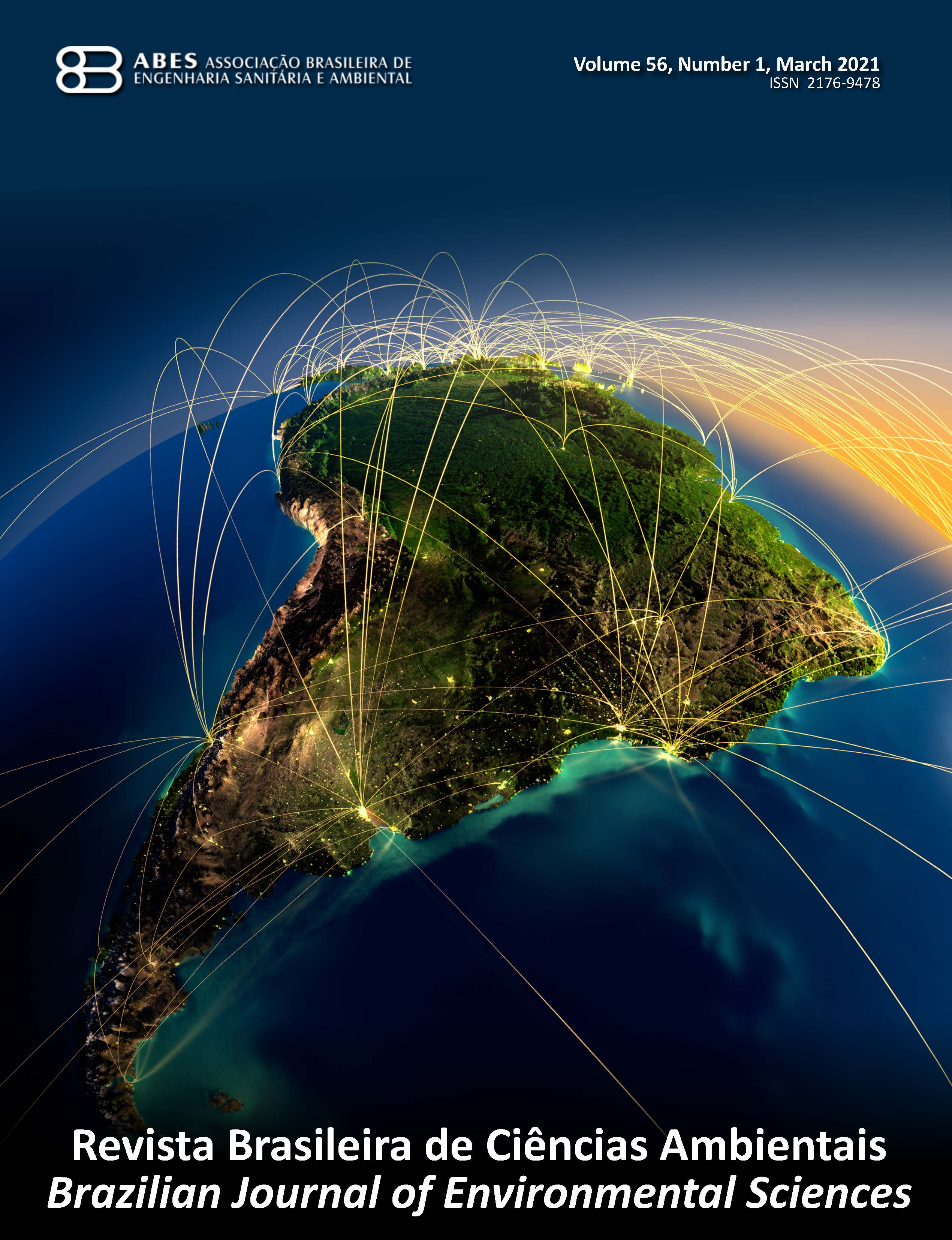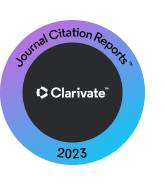Effect of toxicity in Folsomia candida by the use of fungicide and insecticide in subtropical soil
DOI:
https://doi.org/10.5327/Z2176-947820200692Keywords:
springtails; pesticides; Inceptisol; edaphic fauna; terrestrial ecotoxicology.Abstract
Pesticides are widely used for control and prevention against agricultural pests and diseases. The use of these products can negatively affect non-target organisms with important role in soil such as springtails. The present study aimed to evaluate the toxicity of two commercial formulations of pesticides on soil fauna using the springtail Folsomia candida. A natural soil classified as Inceptisol, characteristic of the western region of the Santa Catarina State, was used. The treatments in both tests consisted of six concentrations of the fungicide Comet® (a.i. pyraclostrobin) (0.35; 0.70; 1.40; 2.10; 2.80 and 4.00 mg kg-1 of soil) and of the fungicide + insecticide Standak®Top (a.i. pyraclostrobin + thiophanate-methyl + fipronil) (0.20; 0.60; 1.20; 1.80; 2.40 and 3.00 mg kg-1 soil), plus the control treatment. Acute and chronic tests were carried out following ISO guidelines. Both products proved to be toxic to the evaluated species. Lethality effects were observed in relation to the control of the organisms exposed to low concentrations of the fungicide (0.35 mg kg-1 soil); while for the fungicide + insecticide formulation, lethality was observed at higher concentrations, from 2.40 mg kg-1 soil (LC50 > 3.00 mg kg-1 soil). The reproductive rate was affected only in organisms exposed to the fungicide, with a reduction in the number of juveniles at concentration from 4.00 mg kg-1 soil, with EC20 of 3.38 mg kg-1 soil (2.79–3.96). The results indicate that springtails are sensitive to the tested products, especially to the fungicide that contains the highest concentration of pyraclostrobin in the composition.
Downloads
References
ALVES, P. R. L.; CARDOSO, E. J. B. N.; MARTINES, A. M.; SOUSA, J. P.; PASINI, A. Earthworm ecotoxicological assessments of pesticides used to treat seeds under tropical conditions. Chemosphere, v. 90, n. 11, p. 2674-2682, 2013. https://doi.org/10.1016/j.chemosphere.2012.11.046
ALVES, P. R. L.; CARDOSO, E. J. B. N.; MARTINES, A. M.; SOUSA, J. P.; PASINI, A. Seed dressing pesticides on springtails in two ecotoxicological laboratory tests. Ecotoxicology and Environmental Safety, v. 105, p. 65-71, 2014. https://doi.org/10.1016/j.ecoenv.2014.04.010
BENDING, G. D.; RODRÍGUEZ-CRUZ, M. S.; LINCOLN, S. D. Fungicide impacts on microbial communities in soils with contrasting management histories. Chemosphere, v. 69, n. 1, p. 82-88, 2007. https://doi.org/10.1016/j.chemosphere.2007.04.042
BERTRAND, M.; BAROT, S.; BLOUIN, M.; WHALEN, J.; OLIVEIRA, T.; ROGER-ESTRADE, J. Earthworm services for cropping systems. A review. Agronomy for Sustainable Development, v. 35, p. 553-567, 2015. https://doi.org/10.1007/s13593-014-0269-7
BRASIL. Ministério da Agricultura, Pecuária e Abastecimento (MAPA). AGROFIT. Sistemas de agrotóxicos fitossanitários. Brasil: MAPA, 2020. Available in: <http://agrofit.agricultura.gov.br/agrofit_cons/principal_agrofit_cons>. Accessed on: Abr. 18, 2020.
BROOKS, D. R.; CLARK, S. J.; PERRY, J. N.; BOHAN, D. A.; CHAMPION, G. T.; FIRBANK, L. G.; HAUGHTON, A. J.; HAWES, C.; HEARD, M. S.; WOIWOD, I. P. Invertebrate biodiversity in maize following withdrawal of triazine herbicides. Proceedings of the Royal Society B: Biological Sciences, v. 272, n. 1571, p. 1497-1502, 2005. https://doi.org/10.1098/rspb.2005.3102
BUCH, A. C.; NIEMEYER, J. C.; FERNANDES CORREIA, M. E.; SILVA-FILHO, E. V. Ecotoxicity of mercury to Folsomia candida and Proisotoma minuta (Collembola: Isotomidae) in tropical soils: Baseline for ecological risk assessment. Ecotoxicology and Environmental Safety, v. 127, p. 22-29, 2016. https://doi.org/10.1016/j.ecoenv.2016.01.009
CAMPOS, A. A. B.; SCOTTON, J. C.; COSTA, W. L. F.; GIASSI, V.; PINTO, D. F. P.; HOMMA, S. K. Seleção de fungicidas visando à preservação de fungos micorrízicos arbusculares nativos no cultivo do feijoeiro. Revista Brasileira de Engenharia Agrícola e Ambiental, v. 19, n. 9, p. 898-902, 2015. https://doi.org/10.1590/1807-1929/agriambi.v19n9p898-902
CARNEIRO, F.; RIGOTTO, R. M.; AUGUSTO, L. G.; FRIEDRICH, K. K.; BÚRIGO, A. C. Dossiê ABRASCO: um alerta sobre os impactos dos agrotóxicos na saúde. Rio de Janeiro: EPSJV; São Paulo: Expressão Popular, 2015.
DAAM, M. A.; LEITÃO, S.; CEREJEIRA, M. J.; SOUSA, J. P. Comparing the sensitivity of soil invertebrates to pesticides with that of Eisenia fetida. Chemosphere, v. 85, n. 6, p. 1040-1047, 2011. https://doi.org/10.1016/j.chemosphere.2011.07.032
DABROWSKI, J. M.; SHADUNG, J. M.; WEPENER, V. Prioritizing agricultural pesticides used in South Africa based on their environmental mobility and potential human health effects. Environment International, v. 62, p. 31-40, 2014. https://doi.org/10.1016/j.envint.2013.10.001
EMPRESA BRASILEIRA DE PESQUISA AGROPECUÁRIA (EMBRAPA). Manual de métodos de análise de solo. 2. ed. Rio de Janeiro: EMBRAPA Solos, 2011.
EUROPEAN COMMISSION (EC). Review report for the active substance pyraclostrobin. Finalised in the Standing Committee on the Food Chain and Animal Health at its meeting on 28 November 2003 in view of the inclusion of pyraclostrobin in Annex I of Council Directive 91/414/EEC. SANCO/1420/2001-Final, 08 September 2004. Brussels: European Commission, 2004. Available at: <http://ec.europa.eu/food/plant/pesticides/eu-pesticides-database/public/?event=activesubstance.ViewReview&id=379>. Accessed on: Dec. 4, 2019.
EUROPEAN COMMISSION (EC). Review report for the active substance thiophanate-methyl. inalised in the Standing Committee on the Food Chain and Animal Health at its meeting on 15 February 2005 in view of the inclusion of thiophanate-methyl in Annex I of Directive 91/414/EEC. 5030/VI, 2005. Brussels: European Commission, 2005. Available at: <http://ec.europa.eu/food/plant/pesticides/eu-pesticides-database/public/?event=activesubstance.ViewReview&id=187>. Accessed on: Dec. 4, 2019.
EUROPEAN COMMISSION (EC). Fipronil, product-type PT18 (insecticides, acaricides and products to control other arthropods). Finalised in the Standing Committee on Biocidal Products at its meeting on 6th May 2011 in view of its inclusion in Annex I to Directive 98/8/EC, 2011. Brussels: European Commission, 2011. Available at: http://dissemination.echa.europa.eu/Biocides/ActiveSubstances/0033-18/0033-18_Assessment_Report.pdf. Accessed on: Dec. 4, 2019.
EUROPEAN COMMISSION (EC). The combination effects of chemicals, Chemical mixtures. Communication from the Commission to the Council, COM(2012) 252 final. Brussels: European Commission, 2012. Available at: <http://eur-lex.europa.eu/legal-content/EN/TXT/PDF/?uri=CELEX:52012DC0252&from=EN>. Accessed on: Dec. 4, 2019.
GÜNDEL, S. S.; REIS, T. R.; COPETTI, P. M.; FAVARIN, F. R.; SAGRILLO, M. R.; SILVA, A. S.; SEGAT, J. C.; BARETTA, D.; OURIQUE, A. F. Evaluation of cytotoxicity, genotoxicity and ecotoxicity of nanoemulsions containing Mancozeb and Eugenol. Ecotoxicology and Environmental Safety, v. 169, p. 207-215, 2019. https://doi.org/10.1016/j.ecoenv.2018.11.023
INSTITUTO BRASILEIRO DO MEIO AMBIENTE E DOS RECURSOS NATURAIS RENOVÁVEIS (IBAMA). Boletins anuais de produção, importação, exportação e vendas de agrotóxicos no Brasil. Brasil: IBAMA, 2019. Available in: <https://www.ibama.gov.br/agrotoxicos/relatorios-de-comercializacao-de-agrotoxicos>. Accessed on: Abr. 18, 2020.
INTERNATIONAL ORGANIZATION FOR STANDARDIZATION (ISO). Soil quality – Inhibition of reproduction of Collembola (Folsomia candida) by soil pollutants. ISO 11267. Geneva: ISO, 1999.
JANSA, J.; WIEMKEN, A.; FROSSARD, E. The effects of agricultural practices on arbuscular mycorrhizal fungi. Geological Society, London, Special Publications, v. 266, p. 89-115, 2006. https://doi.org/10.1144/GSL.SP.2006.266.01.08
JÄNSCH, S.; FRAMPTON, G. K.; RÖMBKE, J.; VAN DEN BRINK, P. J.; SCOTT-FORDSMAND, J. J. Effects of pesticides on soil invertebrates in model ecosystem and field studies: a review and comparison with laboratory toxicity data. Environmental Toxicology and Chemistry, v. 25, n. 9, p. 2490-2501, 2006. https://doi.org/10.1897/05-439R.1
JEGEDE, O. O.; OWOJORI, O. J.; RÖMBKE, J. Temperature influences the toxicity of deltamethrin, chlorpyrifos and dimethoate to the predatory mite Hypoaspis aculeifer (Acari) and the springtail Folsomia candida (Collembola). Ecotoxicology and Environmental Safety, v. 140, p. 214-221, 2017. https://doi.org/10.1016/j.ecoenv.2017.02.046
KOUTSAFTIS, A.; AOYAMA, I. Toxicity of four antifouling biocides and their mixtures on the brine shrimp Artemia salina. Science of The Total Environment, v. 387, n. 1-3, p. 166-174, 2007. https://doi.org/10.1016/j.scitotenv.2007.07.023
LORENZATTO, L.; SILVA, M. I.; ROMAN JUNIOR, W.; RODRIGUES JUNIOR, S.; SÁ, C.; CORRALO, V. Rural workers exposure to organophosphates and carbamates. Revista Brasileira de Ciências Ambientais, v. 55, n. 1, p. 19-31, 2020. https://doi.org/10.5327/Z2176-947820200528
MA, J.; CHENG, C.; DU, Z.; LI, B.; WANG, J.; WANG, J.; WANG, Z.; ZHU, L. Toxicological effects of pyraclostrobin on the antioxidant defense system and DNA damage in earthworms (Eisenia fetida). Ecological Indicators, v. 101, p. 111-116, 2019. https://doi.org/10.1016/j.ecolind.2019.01.015
MAJOLO, F.; REMPEL, C. Impact of the use of pesticides by rural workers in Brazil. Revista Brasileira de Ambientais, n. 50, p. 1-25, 2018. https://doi.org/10.5327/Z2176-947820180357
MARTIKAINEN, E. A. T.; KROGH, P. H. Effects of soil organic matter content and temperature on toxicity of dimethoate to Folsomia fimetaria (Collembola: Isotomiidae). Environmental Toxicology and Chemistry, v. 18, n. 5, p. 865-872, 1999. https://doi.org/10.1002/etc.5620180508
NASCIMENTO, L. C.; NAVAL, L. P. Toxicidade determinada pelo uso dos agrotóxicos em organismos indicadores de qualidade da água. Revista Brasileira de Ciências Ambientais, n. 53, p. 69-80, 2019. https://doi.org/10.5327/Z2176-947820190466
NATAL-DA-LUZ, T.; RÖMBKE, J.; SOUSA, J. P. Avoidance tests in site-specific risk assessment--influence of soil properties on the avoidance response of Collembola and earthworms. Environmental Toxicology and Chemistry, v. 27, n. 5, p. 1112-1117, 2008. https://doi.org/10.1897/07-386.1
PELAEZ, V. M.; SILVA, L.; GUIMARÃES, T.; RI, F.; TEODOROVICZ, T. A (des)coordenação de políticas para a indústria de agrotóxicos no Brasil. Revista Brasileira de Inovação, v. 14, p. 153-178, 2015. https://doi.org/10.20396/rbi.v14i0.8649104
PIMENTEL, D. Amounts of pesticides reaching target pests: Environmental impacts and ethics. Journal of Agriculture and Environmental Ethics, v. 8, p. 17-29, 1995. https://doi.org/10.1007/BF02286399
SAKUMA, M. Probit analysis of preference data. Applied Entomology and Zoology, v. 33, n. 3, p. 339-347, 1998. https://doi.org/10.1303/aez.33.339
SÁNCHEZ-BAYO, F. Impacts of agricultural pesticides on terrestrial ecosystems. In: SÁNCHEZ-BAYO, F.; VAN DEN BRINK, P.; MANN, R. (orgs.). Ecological Impacts of Toxic Chemicals. [s.l.]: Bentham Science Publishers, 2011. p. 63-87.
SCHNEIDER, C. A.; RASBAND, W. S.; ELICEIRI, K. W. NIH Image to ImageJ: 25 years of image analysis. Nature Methods, v. 9, p. 671-675, 2012. https://doi.org/10.1038/nmeth.2089
SEGAT, J. C.; MACCARI, A. P.; OLIVEIRA FILHO, L. C. I.; ZEPPELINI, D.; LOPES-LEITZKE, E. R. Ecotoxicologia Terrestre. In: OLIVEIRA FILHO, L. C. I.; SEGAT, J. C.; BARETTA, D.; KLAUBERG FILHO, O. (orgs.). Ecotoxicologia Terrestre: Métodos e aplicações de ensaios com Collembola e Isopoda. Florianópolis: Udesc, 2018. p. 11-50.
SIMÕES, T.; NOVAIS, S. C.; NATAL-DA-LUZ, T.; DEVREESE, B.; DE BOER, T.; ROELOFS, D.; SOUSA, J. P.; VAN STRAALEN, N. M.; LEMOS, M. F. L. Using time-lapse omics correlations to integrate toxicological pathways of a formulated fungicide in a soil invertebrate. Environmental Pollution, v. 246, p. 845-854, 2019. https://doi.org/10.1016/j.envpol.2018.12.069
STATSOFT. STATISTICA (data analysis software system). Tulsa, 2004. Available at: . Accessed on Dec. 4, 2015.
TEDESCO, M. J.; GIANELLO, C.; BISSANI, C. A.; VOLKWEISS, S. J. Análises de Solo, Plantas e Outros Materiais. Porto Alegre: Universidade Federal do Rio Grande do Sul, 1995.
VAN GESTEL, C. A. M.; LIMA E SILVA, C.; LAM, T.; KOEKKOEK, J. C.; LAMOREE, M. H.; VERWEIJ, R. A. Multigeneration toxicity of imidacloprid and thiacloprid to Folsomia candida. Ecotoxicology, v. 26, p. 320-328, 2017. https://doi.org/10.1007/s10646-017-1765-8
YANG, G.; CHEN, C.; WANG, Y.; PENG, Q.; ZHAO, H.; GUO, D.; WANG, Q.; QIAN, Y. Mixture toxicity of four commonly used pesticides at different effect levels to the epigeic earthworm, Eisenia fetida. Ecotoxicology and Environmental Safety, v. 142, p. 29-39, 2017. https://doi.org/10.1016/j.ecoenv.2017.03.037
YOUNG, S. L.; GOLDOWSKY-DILL, N. W.; MUHAMMAD, J.; EPSTEIN, M. M. Connecting experts in the agricultural and meteorological sciences to advance knowledge of pest management in a changing climate. Science of The Total Environment, v. 673, p. 694-698, 2019. https://doi.org/10.1016/j.scitotenv.2019.04.126
ZHANG, C.; ZHOU, T.; ZHU, L.; JUHASZ, A.; DU, Z.; LI, B.; WANG, J.; WANG, J.; SUN, Y. Response of soil microbes after direct contact with pyraclostrobin in fluvo-aquic soil. Environmental Pollution, v. 255, part I, p. 113-164, 2019. https://doi.org/10.1016/j.envpol.2019.113164
ZORTÉA, T.; REIS, T. R.; SERAFINI, S.; SOUSA, J. P.; SILVA, A. S.; BARETTA, D. Ecotoxicological effect of fipronil and its metabolites on Folsomia candida in tropical soils. Environmental Toxicology and Pharmacology, v. 62, p. 203-209, 2018a. https://doi.org/10.1016/j.etap.2018.07.011
ZORTÉA, T.; SILVA, A. S.; REIS, T. R.; SEGAT, J. C.; PAULINO, A. T.; SOUSA, J. P.; BARETTA, D. Ecotoxicological effects of fipronil, neem cake and neem extract in edaphic organisms from tropical soil. Ecotoxicology and Environmental Safety, v. 166, p. 207-214, 2018b. https://doi.org/10.1016/j.ecoenv.2018.09.061
Published
How to Cite
Issue
Section
License
Copyright (c) 2021 Revista Brasileira de Ciências Ambientais

This work is licensed under a Creative Commons Attribution 4.0 International License.


























